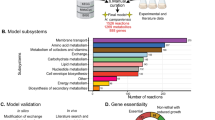Abstract
Klebsiella pneumoniae is known to produce meso-2,3-butanediol and 2S,3S-butanediol, whereas 2R,3R-butanediol was detected in the culture broth of K. pneumoniae CGMCC 1.6366. The ratio of 2R,3R-butanediol to all isomers obtained using glycerol as the carbon source was higher than that obtained using glucose as the carbon source. Therefore, enzymes involved in glycerol metabolism are likely related to 2R,3R-butanediol formation. In vitro reactions show that glycerol dehydrogenase catalyzes the stereospecific conversion of R-acetoin to 2R,3R-butanediol and S-acetoin to meso-2,3-butanediol. Butanediol dehydrogenase exhibits high (S)-enantioselectivity in ketone reduction. Genes encoding glycerol dehydrogenase, α-acetolactate decarboxylase, and butanediol dehydrogenase were individually disrupted in K. pneumoniae CGMCC 1.6366, and the 2,3-butanediol synthesis characteristics of these mutants were investigated. K. pneumoniae ΔdhaD lost the ability to synthesize 2R,3R-butanediol. K. pneumoniae ΔbudA showed reduced 2R,3R-butanediol synthesis. However, K. pneumoniae ΔbudC produced a high level of 2R,3R-butanediol, and R-acetoin was accumulated in the broth. The metabolic characteristics of these mutants and in vitro experiment results demonstrated the mechanism of the 2,3-butanediol stereoisomer synthesis pathway. Glycerol dehydrogenase, encoded by dhaD, exhibited 2R,3R-butanediol dehydrogenase activity and was responsible for 2R,3R-butanediol synthesis from R-acetoin. This enzyme also contributed to meso-2,3-butanediol synthesis from S-acetoin. Butanediol dehydrogenase, encoded by budC, was the only enzyme that catalyzed the conversion of diacetyl to S-acetoin and further to 2S,3S-butanediol.






Similar content being viewed by others
References
Blomqvist K, Nikkola M, Lehtovaara P, Suihko M, Airaksinen U, Straby K, Knowles J, Penttila M (1993) Characterization of the genes of the 2,3-butanediol operons from Klebsiella terrigena and Enterobacter aerogenes. J Bacteriol 175:1392–1404
Celinska E, Grajek W (2009) Biotechnological production of 2,3-butanediol—current state and prospects. Biotechnol Adv 27:715–725
Forage RG, Foster MA (1982) Glycerol fermentation in Klebsiella pneumoniae: functions of the coenzyme B12-dependent glycerol and diol dehydratases. J Bacteriol 149:413–419
Gao J, Xu H, Li Q, Feng X, Li S (2010) Optimization of medium for one-step fermentation of inulin extract from Jerusalem artichoke tubers using Paenibacillus polymyxa ZJ-9 to produce R,R-2,3-butanediol. Bioresour Technol 101:7076–7082
Gao J, H-h Y, X-h F, Li S, Xu H (2013) A 2,3-butanediol dehydrogenase from Paenibacillus polymyxa ZJ-9 for mainly producing R,R-2,3-butanediol: purification, characterization and cloning. J Basic Microbiol 53:733–741
Gust B, Challis GL, Fowler K, Kieser T, Chater KF (2003) PCR-targeted Streptomyces gene replacement identifies a protein domain needed for biosynthesis of the sesquiterpene soil odor geosmin. Proc Natl Acad Sci U S A 100:1541–1546
Häßler T, Schieder D, Pfaller R, Faulstich M, Sieber V (2012) Enhanced fed-batch fermentation of 2,3-butanediol by Paenibacillus polymyxa DSM 365. Bioresour Technol 124:237–244
Hao J, Lin R, Zheng Z, Liu H, Liu D (2008) Isolation and characterization of microorganisms able to produce 1,3-propanediol under aerobic conditions. World J Microbiol Biotechnol 24:1731–1740
Lee S, Kim B, Park K, Um Y, Lee J (2012) Synthesis of pure meso-2,3-butanediol from crude glycerol using an engineered metabolic pathway in Escherichia coli. Appl Biochem Biotechnol 166:1801–1813
Li L, Wang Y, Zhang L, Ma C, Wang A, Tao F, Xu P (2012) Biocatalytic production of (2S,3S)-2,3-butanediol from diacetyl using whole cells of engineered Escherichia coli. Bioresour Technol 115:111–116
Stormer F (1975) 2,3-Butanediol biosynthetic system in Aerobacter aerogenes. Methods Enzymol 41:518–533
Ui S, Masuda T, Masuda H, Muraki H (1986) Mechanism for the formation of 2,3-butanediol stereoisomers in Bacillus polymyxa. J Ferment Technol 64:481–486
UI S, Matsuyama N, Masuda H, Muraki H (1984) Mechanism for the formation of 2,3-butanediol stereoisomers in Klebsiella pneumoniae. J Ferment Technol 62:551–559
Ui S, Mimura A, Ohkuma M, Kudo T (1999) Formation of a chiral acetoinic compound from diacetyl by Escherichia coli expressing meso 2,3-butanediol dehydrogenase. Lett Appl Microbiol 28:457–460
Ui S, Mimura A, Okuma M, Kudo T (1998) The production of d-acetoin by a transgenic Escherichia coli. Lett Appl Microbiol 26:275–278
Ui S, Okajima Y, Mimura A, Kanai H, Kobayashi T, Kudo T (1997) Sequence analysis of the gene for and characterization of d-acetoin forming meso-2,3-butanediol dehydrogenase of Klebsiella pneumoniae expressed in Escherichia coli. J Ferment Bioeng 83:32–37
Voloch M, Ladisch M, Rodwell V, Tsao G (1983) Reduction of acetoin to 2,3-butanediol in Klebsiella pneumoniae: a new model. Biotechnol Bioeng 25:173–183
Wang Q, Chen T, Zhao X, Chamu J (2012) Metabolic engineering of thermophilic Bacillus licheniformis for chiral pure d-2,3-butanediol production. Biotechnol Bioeng 109:1610–1621
Wang Z, Song Q, Yu M, Wang Y, Xiong B, Zhang Y, Zheng J, Ying X (2013) Characterization of a stereospecific acetoin (diacetyl) reductase from Rhodococcus erythropolis WZ010 and its application for the synthesis of (2S,3S)-2,3-butanediol. Appl Microbiol Biotechnol. doi:10.1007/s00253-013-4870-5
Wei D, Wang M, Shi J, Hao J (2012) Red recombinase assisted gene replacement in Klebsiella pneumoniae. J Ind Microbiol Biotechnol 39:1219–1226
Wei D, Xu J, Sun J, Shi J, Hao J (2013) 2-Ketogluconic acid production by Klebsiella pneumoniae CGMCC 1.6366. J Ind Microbiol Biotechnol 40:561–570
Xiao Z, Xu P (2007) Acetoin metabolism in bacteria. Crit Rev Microbiol 33:127–140
Yan Y, Lee C, Liao J (2009) Enantioselective synthesis of pure (R,R)-2,3-butanediol in Escherichia coli with stereospecific secondary alcohol dehydrogenases. Org Biomol Chem 7:3914
Zhang GL, Wang CW, Li C (2012) Cloning, expression and characterization of meso-2,3-butanediol dehydrogenase from Klebsiella pneumoniae. Biotechnol Lett 34:1519–1523
Acknowledgments
This work was financially supported by the National Natural Science Foundation of China (grant no. 20906076).
Author information
Authors and Affiliations
Corresponding authors
Rights and permissions
About this article
Cite this article
Chen, C., Wei, D., Shi, J. et al. Mechanism of 2,3-butanediol stereoisomer formation in Klebsiella pneumoniae . Appl Microbiol Biotechnol 98, 4603–4613 (2014). https://doi.org/10.1007/s00253-014-5526-9
Received:
Revised:
Accepted:
Published:
Issue Date:
DOI: https://doi.org/10.1007/s00253-014-5526-9




